By: Lynn Barker
You might think you are familiar with the isolated island of Madagascar from the Madagascar animated films that, besides fun animals Alex, Gloria, Melman and Marty, depicted loveable lemurs whose territory they invaded. In Island of Lemurs: Madagascar you see the real thing along with the most amazing plants and weird, almost alien terrain on our planet.
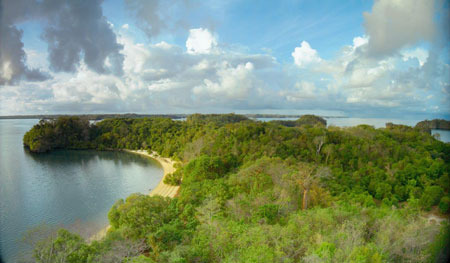 Beautiful MadagascarCourtesy of Warner Bros.
Beautiful MadagascarCourtesy of Warner Bros.
The filmmakers took a 50 pound IMAX camera to very hard-to-reach, isolated locales and shot the film high over the jungle and up sheer mountain cliffs. A director and cameraman floated around sitting in a lawnchair-like seat under a propeller-equipped balloon. They also used a tower that reached high up in the trees where the lemurs hang out.
 Balloon with IMAX camera and director over MadagascarCourtesy of Warner Bros.
Balloon with IMAX camera and director over MadagascarCourtesy of Warner Bros.
The filmmakers made sure to be quiet and relaxed around the lemurs when shooting the movie because they can sense when we are upset and don’t want to have anything to do with us. Lemurs checked out the film equipment to see if it was something to eat. It wasn’t so they just went about their interesting, personal business and it ended up in the movie. The things you see in the film; some lemur species “dancing” and others “singing” is what blew the minds of the filmmakers. They wanted to share this with the world.
 Dancing lemur with buddiesCourtesy of Warner Bros.
Dancing lemur with buddiesCourtesy of Warner Bros.
Kidzworld was in downtown Los Angeles, near the California Science Center talking with Dr. Patricia Wright, the strongest lemur advocate working in Madagascar, about her love for these funny, friendly creatures. The great actor Morgan Freeman, whom you’ve seen in countless films, including the animal-friendly Dolphin Tale, narrates the short movie and expressed to us his desire to save these animals.
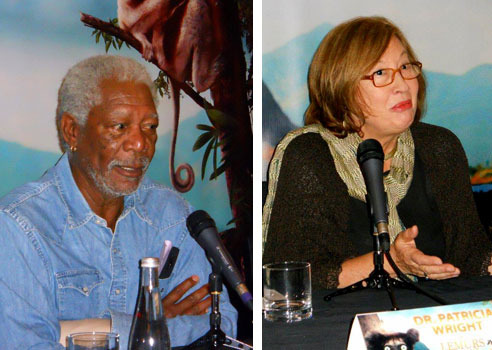 Actor/Narrator Morgan Freeman and Dr. Patricia Wright Scientist/Activist for the lemursCourtesy of Lynn Barker
Actor/Narrator Morgan Freeman and Dr. Patricia Wright Scientist/Activist for the lemursCourtesy of Lynn Barker
While we were talking, a keeper brought in a brown lemur named Taj who hopped and bounced from person to person ending up gripping the shoulder of David Douglas (director/cinematographer). Someone asked “Is it a boy or a girl?” Morgan Freeman said “He acts like a male. Did you know they have four fingers and an opposable thumb (like humans)?”
 Your reporter with ringtailed lemurCourtesy of Lynn Barker
Your reporter with ringtailed lemurCourtesy of Lynn Barker
Some of the fun songs in the film are sung by and some written by Malagasy native “popstar” Hanitrarivo Rasoanaivo (call her Hanitra). She grew up with lemurs.
 Let's hang out!Courtesy of Warner Bros.
Let's hang out!Courtesy of Warner Bros.
Kidzworld: Is the film accurate to the lemurs’ actual behavior?
- Hanitra: Lemurs are very intelligent. They know what they’re doing. For us Malagasy people it’s great that the (filmmakers) have brought the lemurs all the way to Hollywood. For us, it’s a normal thing to see them doing their stuff; 100 different varieties doing all different things. The shame about it is all Malagasy people can’t go into the forest to see them. They aren’t jumping around everywhere, only scattered places. I hope a film like this will keep them alive.
 Colorful singer from Madagascar Hanitra Rasoanaivo
Colorful singer from Madagascar Hanitra Rasoanaivo
 Look guys! Dessert!Courtesy of Warner Bros.
Look guys! Dessert!Courtesy of Warner Bros.
Kidzworld: We know lemurs are fuzzy and cute as heck. We just saw one in action, but Patricia and Morgan, what is it about lemurs that particularly endears them to you?
- Morgan: I didn’t know lemurs. This is the first time I’ve had this close a connection with them. However, I had a friend who has a place in the Caribbean and he raises them. So, on a visit, I guess a year ago, I was introduced to them up close and personal. They are obviously in a little bit of trouble (in the wild) and he’s doing what he can to help rejuvenate their population. So, I got a little bit of history about them. Not nearly what I got doing (narration) on this movie. They’re terrific little creatures.
- Patricia: There are several reasons why I like them. They’re so special and they are like nothing else on earth. They are beautiful animals but each one is so different. There’s 103 different species! Some eat bamboo, some eat seeds, some, leaves, some, insects. But each one of the species does their own thing. Every one of them is cute in its own way.
- The reason I’ve stayed in Madagascar as long as I have working with lemurs is because they are so endangered. Ninety-one percent of them are either threatened or critically endangered or endangered and I feel I can do something and maybe this film can do something so they will survive into the future.
Kidzworld: What is the major problem that they have? Is it habitat encroachment or are people eating them?
- Patricia: The deforestation and slash and burn farming is a problem and has been for a while and it used to be that the village elders who had all the wisdom, would say “Do not eat the lemurs because they so much like us; their hands, their faces. They are special and sacred” but recently people aren’t listening as much to the village elders so hunting has become much more of a problem. That is a problem because the Indri (a lemur species) gives birth only every three years and it’s big and good for hunting so that’s a problem.
- Morgan: So what are we doing? (It seems that) if we can’t eat it, we’ll just get rid of it and take its place, move it out of the way. There were no humans on Madagascar when the lemurs got there so life flourished as life does….without us.
 An Indri lemur, the largest living lemurCourtesy of Warner Bros.
An Indri lemur, the largest living lemurCourtesy of Warner Bros.
Kidzworld: How long do they usually live?
- Patricia: The Sifakas (one kind of lemur) lives over 30 years. The little mouse lemurs, some are twelve years old and they are the size of a mouse that fits in your hand. A mouse lives two years.
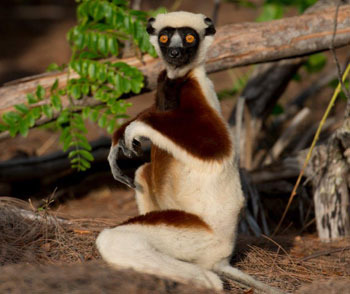 A Sifaka lemur gets a surpriseCourtesy of Warner Bros.
A Sifaka lemur gets a surpriseCourtesy of Warner Bros.
Kidzworld: Morgan, you narrate so many of these great nature films. Is it a cause with you?
- Morgan: If we are going to be doing something that might give some succor or attention and consideration to the other life forms on our planet, I’m happy to do it. It’s an obligation. I think the educational value is what comes first. I’ve always thought that the most effective tools we have for (spreading) information is television and film. People are glued to television. Our children, we can’t get them into the park so we need to present the right stuff to them if they are going to be watching television. I have this belief in giving useful information about the planet and the diverse biology of it. I’ve dedicated myself to being available for anything that helps that along.
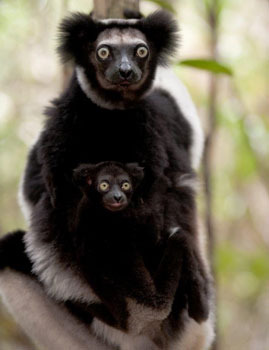 Indri Lemur with babyCourtesy of Warner Bros.
Indri Lemur with babyCourtesy of Warner Bros.
Up to Us
It is up to humans to educate everyone about these beautiful, friendly creatures and protect them as much as possible. Scientists like Dr. Patricia Wright are dedicating their lives to it. You can help too. Write reports for school on lemurs to let everyone know about them and the danger they face or “adopt” a lemur! Check out what you can do here.
Catch Island of Lemurs: Madagascar in IMAX theaters starting April 4th!
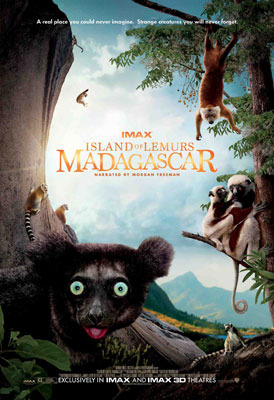 Island of Lemurs: Madagascar PosterCourtesy of Warner Bros.
Island of Lemurs: Madagascar PosterCourtesy of Warner Bros.
Island of Lemurs: Madagascar Trailer





































